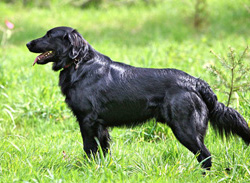Flat-Coated Retrievers are larger dogs with solid black or liver-colored coats that lie flat and straight. Their lustrous coats are moderately long and dense and provide protection against water and all types of weather. In silhouette, these dogs have a long, "one-piece" head that's unique to the Flat-Coated Retriever breed. Their dark, wide-set eyes are medium-sized and almond shaped, and their ears are small. These dogs measure 22 to 24.5 inches tall at the shoulder and weigh 60 to 70 pounds.
Obedience training can help minimize problem behaviors common to this breed, such as jumping when greeting, pulling when on a leash, and ignoring commands.
While most Flat-Coated Retrievers would rather hunt than do anything else, they do enjoy spending time and engaging in other activities with their human family members. These dogs are especially fond of dock-diving and swimming, but they also enjoy hiking, running, cross-country skiing, and other activities. Overall, they make excellent companion animals for active families, and they get along with just about everyone.
Because of the cheerful, energetic, and often rambunctious nature of the Flat-Coated Retriever, this breed is sometimes referred to as the Peter Pan of dogs. They are eager to please, very friendly, and slow to mature.
Flat-Coated Retrievers are known for their cheerful, good-natured, and optimistic personalities. They make excellent family companions, are great with children, get along well with other pets, and are generally tolerant and adaptable. They are also very affectionate and tend to form close bonds with their human family members.
These active dogs require vigorous exercise to remain healthy and happy. Flat-Coated Retrievers enjoy dog sports and perform well at agility and obedience, but hunting is the only thing that can fully satisfy them both mentally and physically. Keeping them busy is an important part of managing their behavior and ensuring they remain cheerful.
Without regular activity and plenty of human affection and interaction, these dogs may become lonely, bored, or depressed. Flat-Coated Retrievers should live indoors and play outdoors, and they should never be left alone to fend for themselves for too long. These dogs need to be part of a family unit.
Flat-Coated Retrievers are known to suffer from several serious hereditary conditions that can negatively affect quality or length of life. These include cancer, congenital hip dysplasia, luxating patellas, and progressive retinal atrophy. Additionally, the breed is prone to diabetes, glaucoma, and epilepsy.
These dogs are also at increased risk for heat-related injuries and illnesses. Because of their coloring, Flat-Coated Retrievers are exceptionally sensitive to the heat and can overheat quickly in warm or hot conditions. Care must be taken to keep these dogs cool. The breed must be moved to a cool location at the first sign of overheating, and suspected heatstroke must be treated immediately to prevent long-term complications or death.
With routine veterinary care, proper nutrition, regular exercise, and attention to overheating, these dogs usually live 10 to 13 years. Regular veterinary checkups ensure prompt diagnosis and treatment of genetic illnesses and can prolong life.
These dogs are easy to train, eager to please, and generally in a good mood. However, they need regular exercise to release excess energy and early training and socialization to help control their hyperactive tendencies. Socialization and training will also help prevent Flat-Coated Retrievers from becoming shy, nervous, or apathetic.
Obedience training can help minimize problem behaviors common to this breed, such as jumping when greeting, pulling when on a leash, and ignoring commands. These dogs are sensitive and do not respond well to harsh criticism during training. Play and food rewards work best, but they also respond well to other forms of positive reinforcement, including praise.
Even with training, these dogs will likely remain attention hogs and occasional food thieves. Also, they tend to mature slowly and are known for their prolonged adolescence. These issues make patience and tolerance a must for anyone opening their home to a Flat-Coated Retriever.
Flat-Coat Retrievers are one of the easiest of the Sporting breeds to groom. In most cases, these dogs need only occasional brushing and infrequent bathing. Weekly brushing will removed dead hair, distribute skin oils, and prevent tangles and mats. Minor trimming on the ears and feet can improve neatness.
Dogs that spend a lot of time in the water may need even less frequent bathing than usual, although a thorough rinse is important to remove chlorine, salt, or algae. Also, because prolonged exposure to water makes ear infections more likely, it's important to check the Flat-Coated Retriever's ears frequently for signs of infection, which can include odor, redness, pain, and discharge.
The nails need trimming every few weeks, and the teeth require regular brushing and periodic examinations by a veterinarian. Dental treats and rinses are beneficial and can reduce the risk of gum disease and cavities. The ears should be checked often for excess wax accumulation and cleaned with a cotton ball and veterinarian-approved otic cleanser.
Flat-Coated Retrievers were originally developed to flush and retrieve waterfowl and game. They helped retrieve fish from the water for fishermen and became immensely popular with Newfoundland cod fisheries. Their impressive swimming ability, natural retrieving skills, and excellent bird sense made these dogs beloved hunting companions.
Ancestors of the Flat-Coated Retriever include the "Retriever Proper," which was a cross-breed developed from combining the Large Newfoundland, sheepdog, setter, and spaniel-like water dogs. They were first known as generic "Labrador" dogs and then became the Wavy-Coated Retriever. After being crossed with straighter-haired breeds to improve the water-repellent properties of their coats, they became known as Flat-Coated Retrievers and their popularity increased.
As time went on, their popularity dropped, and by the end of World War II, the breed's numbers had decreased to the point of near-extinction. Efforts to bring the breed back slowly succeeded, and the breed is now moderately popular in the United States. An increase in the breed's numbers in the future is expected.
The American Kennel Club officially recognized the Flat-Coated Retriever in 1915.

